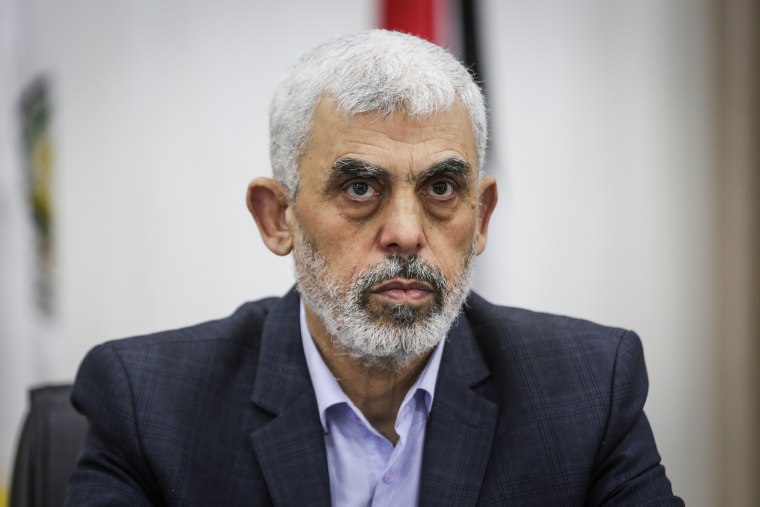Historical Context and Leadership Transitions: Israel Hamas Leader

The history of Hamas is inextricably intertwined with the Israeli-Palestinian conflict. Founded in 1987, Hamas emerged as a response to the first Palestinian Intifada, a popular uprising against Israeli occupation. Its leadership has evolved over time, reflecting the organization’s changing priorities and the dynamics of the conflict.
Founding and Early Leadership, Israel hamas leader
Hamas was founded by Sheikh Ahmed Yassin, a Palestinian cleric who was known for his fiery sermons and his unwavering commitment to Palestinian self-determination. Yassin, along with other prominent figures like Abdel Aziz Rantisi, established the organization as a militant and political movement dedicated to resisting Israeli occupation and establishing an Islamic state in the entirety of historic Palestine. Yassin’s leadership was characterized by his strong religious convictions and his unwavering belief in armed struggle as a means to achieve Palestinian liberation.
Leadership Transitions and Internal Dynamics
Following the assassination of Sheikh Yassin in 2004, Hamas leadership transitioned to Khaled Meshaal, a political strategist known for his diplomatic skills and his ability to navigate the complex international landscape. Meshaal’s leadership ushered in a period of increased focus on political negotiations and international diplomacy, while maintaining the organization’s commitment to armed resistance.
However, internal dynamics within Hamas have always been complex. The organization is comprised of various factions, each with its own ideology and approach to the conflict. These factions have competed for influence and power, often leading to internal disputes and challenges to leadership.
The Relationship with Israel
The relationship between Israel and Hamas has been characterized by a long history of conflict and violence. Hamas’s founding charter calls for the destruction of Israel, and the organization has carried out numerous attacks against Israeli targets. Israel, in turn, has responded with military operations and targeted assassinations of Hamas leaders.
The conflict has resulted in a cycle of violence and instability, with no end in sight. Significant events that have shaped the relationship between Israel and Hamas include:
- The First Intifada (1987-1993): This uprising was a turning point in the Israeli-Palestinian conflict, leading to the emergence of Hamas as a major player.
- The Oslo Accords (1993-1995): While Hamas initially opposed the Oslo Accords, the organization later participated in Palestinian elections, winning a majority of seats in the Palestinian Legislative Council in 2006.
- The Second Intifada (2000-2005): This period witnessed a surge in violence, with Hamas carrying out numerous suicide bombings against Israeli targets.
- The Gaza War (2008-2009): This war was a major turning point in the relationship between Israel and Hamas, resulting in a humanitarian crisis in Gaza and a significant loss of life.
- The Israeli-Gaza Conflict (2012, 2014, 2021): These conflicts have further escalated tensions and led to a deterioration in the humanitarian situation in Gaza.
Ideology and Political Goals

Hamas, a Palestinian Islamic resistance movement, has a complex and evolving ideology that shapes its political goals and actions. Its stated objectives, often presented as a fight for Palestinian liberation and self-determination, have been subject to considerable scrutiny, particularly in light of its history of armed conflict and its commitment to the destruction of Israel.
The Hamas Charter and its Evolution
The Hamas Charter, adopted in 1988, Artikels the movement’s core beliefs and objectives. It explicitly calls for the establishment of an Islamic state in all of Palestine, including territories currently under Israeli control. The charter rejects the legitimacy of Israel and advocates for its eventual destruction. However, Hamas has shown a degree of flexibility in its interpretation of the charter over time. In recent years, there have been calls for a reassessment of its language, particularly regarding the explicit call for Israel’s destruction. This shift in tone has been attributed to a combination of factors, including international pressure, the changing political landscape in the Middle East, and internal debates within Hamas itself.
The Role of Religion and Islamic Ideology
Religion plays a central role in shaping Hamas’s political agenda. The movement draws heavily on Islamic ideology, interpreting it as a framework for political action and social transformation. Hamas views the conflict with Israel as a religious struggle, drawing on Quranic verses and Islamic history to justify its resistance. The movement’s leadership often frames its actions as a defense of Islamic values and the rights of Palestinians, appealing to a sense of religious obligation among its supporters. This religious dimension adds a layer of complexity to Hamas’s political goals, as it intertwines religious beliefs with political aspirations.
“The Islamic Resistance Movement (Hamas) is a Palestinian movement whose goal is to liberate Palestine, all of Palestine, and establish an Islamic Palestinian state in all of Palestine.” – Hamas Charter, 1988
Israel hamas leader – The conflict between Israel and Hamas is a complex and multifaceted issue, with both sides having their own narratives and motivations. While the world grapples with finding a solution, it’s important to remember that even seemingly unrelated topics can offer insights.
For instance, the concept of protecting and enhancing something valuable, like a cherished recliner, is mirrored in the need to safeguard human life and well-being. An oversized recliner chair cover can shield furniture from wear and tear, just as diplomatic efforts aim to shield civilians from the devastating effects of conflict.
Ultimately, the pursuit of peace requires a shared commitment to safeguarding what is precious, whether it be a comfortable chair or the lives of innocent people.
The conflict between Israel and Hamas leaders is a complex and deeply rooted issue. While these leaders strive for their respective visions, the lives of ordinary people are affected in profound ways. Finding solutions requires a commitment to peace and understanding.
For example, innovative designs like folding tables with chair storage provide practical solutions in limited spaces, reminding us that even amidst conflict, human ingenuity can offer hope for a better future. The path to peace requires both political will and practical solutions, and it is in this spirit that we must approach the challenges faced by Israel and Hamas leaders.
